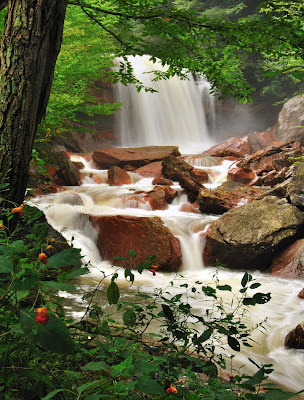Exploring the North Fork of the Blackwater River: Douglas Falls
�Perhaps in all this broad land of ours, whose wonders are not yet half revealed, no scene more beautifully grand ever broke on the eye of poet or painter, historian or forester. The Blackwater here evidently breaks its way sheer down through one of the ribs of the backbone of the Alleganies. The chasm through which the river forces itself thus headlong tumultuous down, is just wide enough to contain the actual breadth of the stream. On either side, the mountains rise up, almost a perpendicular ascent, to the height of some six hundred feet. They are covered down their sides, to the very edge of the river, with the noblest of firs and hemlocks . . .�
�Turning a rocky promontory that jutted the mountain side, the Blackwater, some hundred yards ahead, seemed to have disappeared entirely from the face of the earth, leaving nothing visible down the chasm through which it vanished, but the tops of fir-trees and hemlocks . . . The expedition stepped out upon the furthest verge and very pinnacle of the foaming battlements, and gazed upon the sight so wondrous and so wild, thus presented to their astonished eyes.�
They were approaching the brink of what is now called Douglas Falls�the point at which the North Fork of the Blackwater River begins its precipitous descent into the Main Fork. Further discoveries lay ahead as chronicled by Kennedy in his book.
When you reach a Forest Service gate across the road, the falls will be immediately to your left. Take the path that leads down to the falls and explore them. The falls drop some 40 feet into an emerald plunge pool surrounded by huge prisms of rusty-red sandstone. The rocks are tinted red by iron-bearing minerals leached from acid mine drainage upstream. The coal mines have since been reclaimed, but the boulders are colorful reminders of the past pollution. Douglas Falls are not as high or as wide as the Great Falls of the Main Fork of the Blackwater, but they are picturesque and beautiful nonetheless. In fact I find them stunning.
 |
| Douglas Falls |
The Blackwater Chronicle
Philip Pendleton Kennedy penned those words in 1852 in a colorful account called The Blackwater Chronicle: A Narrative of and Expedition into the Land of Canaan. And who could blame him for waxing poetic. He was leading a party of fellow adventurers into a raw and relatively unexplored region of West Virginia�Canaan Valley and the upper watershed of the Blackwater River. The explorers were lured by the keeper of the Tower�s Inn in Gormania who boasted: �Gentlemen, if you can only reach the fall of the Blackwater, you can take more trout in an hour than you ever took before in all your lives.� That did not prove to be an exaggeration. Kennedy and his company caught native trout, which had never before seen a baited hook, by the hundreds. |
| Douglas Falls |
Douglas Falls
The wilds of Canaan, however, did not easily yield their treasures. These men sloshed through dank swamps and slashed through dense laurel thickets. The going was tough, but the rewards were grand. Kennedy�s party had crossed Backbone Mountain and were descending the North Fork of the Blackwater River when they came upon an inspiring scene. Kennedy breathlessly described it this way:�Turning a rocky promontory that jutted the mountain side, the Blackwater, some hundred yards ahead, seemed to have disappeared entirely from the face of the earth, leaving nothing visible down the chasm through which it vanished, but the tops of fir-trees and hemlocks . . . The expedition stepped out upon the furthest verge and very pinnacle of the foaming battlements, and gazed upon the sight so wondrous and so wild, thus presented to their astonished eyes.�
 |
| Douglas Falls |
They were approaching the brink of what is now called Douglas Falls�the point at which the North Fork of the Blackwater River begins its precipitous descent into the Main Fork. Further discoveries lay ahead as chronicled by Kennedy in his book.
Exploring the North Fork
But is there any adventure left for us in the Land of Canaan some 150 years later? Can we follow in the footsteps of these explorers and experience the wonder they felt? The answer is, �Yes!� If you�re lodging at Blackwater Falls State Park or in surrounding areas and are willing to stay a few more days, then I suggest you spend some time exploring the North Fork of the Blackwater River. It�s only 4 miles from the state park. If you do, you�ll get a taste of adventure and discover for yourself some scenic gems that few people have seen since Kennedy and his men forged the way in 1852. |
| Douglas Falls |
How to Get to Douglas Falls
An excursion on the North Fork should start at Douglas Falls (Lat 39.12403, Long -79.51965). Beginning from the entrance to Blackwater Falls State Park at State Route 32, drive about two miles north on Route 32 until you come to the Douglas-Coketon Road on your left. After leaving Route 32, drive about a mile to a bridge crossing the North Fork. Immediately after the bridge look for a gravel road to the left, which is an abandoned railroad grade that runs along the length of the North and Main Forks of the Blackwater River all the way from Thomas to Hendricks. It�s a great bike path. Up to Douglas Falls, it�s also passable by vehicle. But I wouldn�t try it with my sedan. It has some deep potholes that require a vehicle with high clearance. |
| Beehive Coke Ovens |
Beehive Coke Ovens
Since Douglas Falls are just a mile down the road and the way is fairly level, you can hike, bike, or drive it pretty easily. On the way keep your eye out for some abandoned coke ovens on your left. One look at the structures and you�ll know why they were called �beehive� coke ovens. The way is strewn with wildflowers, too, and occasional glimpses of the North Fork of the Blackwater. Although this is a fairly flat stretch, the river does make a couple of short leaps and runs over sandstone ledges. |
| North Fork of the Blackwater R. |
When you reach a Forest Service gate across the road, the falls will be immediately to your left. Take the path that leads down to the falls and explore them. The falls drop some 40 feet into an emerald plunge pool surrounded by huge prisms of rusty-red sandstone. The rocks are tinted red by iron-bearing minerals leached from acid mine drainage upstream. The coal mines have since been reclaimed, but the boulders are colorful reminders of the past pollution. Douglas Falls are not as high or as wide as the Great Falls of the Main Fork of the Blackwater, but they are picturesque and beautiful nonetheless. In fact I find them stunning.
 |
| Douglas Falls |



Comments
Post a Comment